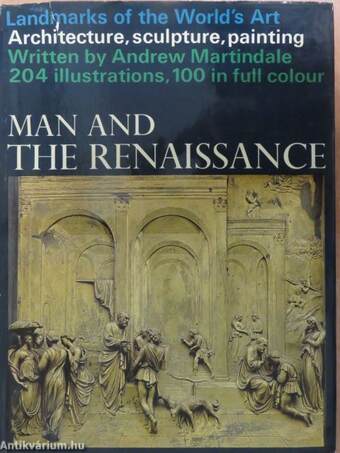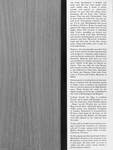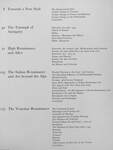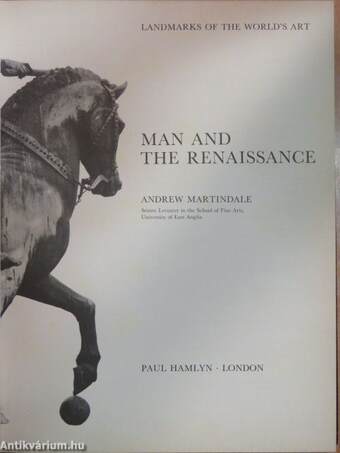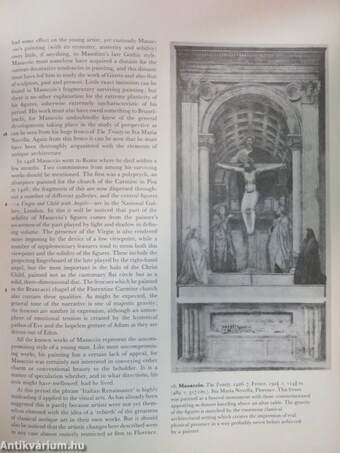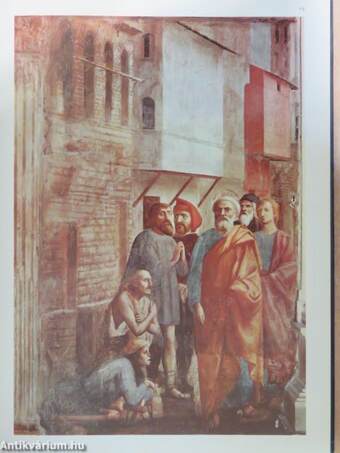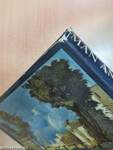1.067.669
kiadvánnyal nyújtjuk Magyarország legnagyobb antikvár könyv-kínálatát

VISSZA
A TETEJÉRE
JAVASLATOKÉszre-
vételek
Man and the renaissance
| Kiadó: | Paul Hamlyn |
|---|---|
| Kiadás helye: | London |
| Kiadás éve: | |
| Kötés típusa: | Fűzött keménykötés |
| Oldalszám: | 176 oldal |
| Sorozatcím: | Landmarks of the World's Art |
| Kötetszám: | |
| Nyelv: | Angol |
| Méret: | 29 cm x 22 cm |
| ISBN: | |
| Megjegyzés: | Színes és fekete-fehér fotókkal, reprodukciókkal, illusztrációkkal. |
naponta értesítjük a beérkező friss
kiadványokról
naponta értesítjük a beérkező friss
kiadványokról
Fülszöveg
the worjd 'renaissance' is familiar and much used. But how many people could easily explain what it meant to artists, scholars and patrons in i5th-century Europe? In 1400, when this volume opens, Europeans did not know what 'Europe' meant. There was only 'Christendom'. And in their medieval world there was only one style of art: international, Catholic, Gothic art. Yet by 1500, Michelangelo had carved his Piéta in St Peter's, Romé, Leonardo had painted The Virgin of the Rocks and The Last Supper, Dürer had returned to Nürnberg from Venice, spreading an entirely new style of art north of the Alps. Gutenberg's and Caxton's printing presses were at work. America had been discovered. Constantinople had been lost. In less than twenty years, Calvin and Luther were to split the Universal Church. Florence, rich and powerful, provided Italy with its first nucleus of artists experimenting with perspective, imitating classical figures, studying Román architecture: Brunelleschi, Donatello,... TovábbFülszöveg
the worjd 'renaissance' is familiar and much used. But how many people could easily explain what it meant to artists, scholars and patrons in i5th-century Europe? In 1400, when this volume opens, Europeans did not know what 'Europe' meant. There was only 'Christendom'. And in their medieval world there was only one style of art: international, Catholic, Gothic art. Yet by 1500, Michelangelo had carved his Piéta in St Peter's, Romé, Leonardo had painted The Virgin of the Rocks and The Last Supper, Dürer had returned to Nürnberg from Venice, spreading an entirely new style of art north of the Alps. Gutenberg's and Caxton's printing presses were at work. America had been discovered. Constantinople had been lost. In less than twenty years, Calvin and Luther were to split the Universal Church. Florence, rich and powerful, provided Italy with its first nucleus of artists experimenting with perspective, imitating classical figures, studying Román architecture: Brunelleschi, Donatello, Masaccio. Soon their new style was heralded by scholars and patrons as a great 'rebirth' of the glory of classical antiquity. That was what the word Renaissance meant to them. The new idiom quickly won adherents in other cities: Mantegna at Padua and Mantua, Piero della Francesca at Ferrara and Urbino, Bramante at Milán. Enthusiasm for recreating the style of ancient Romé combined with the abundant genius of Italian artists to produce the mounting tide of creativity known as the High Renaissance. Romé became the centre for the highest quality art of the age, symbolised by the work of Michelangelo and Raphael. Looking beyond the Alps, to northern Europe and to Spain and Portugál, we see how the dominance of the Flemish masters -Roger van der Weyden, Jan van Eyck, Hugó van der Goes-faded after about 1475. Italian artists were imported-Torrigiano to London, Primaticcio to Fontainebleau. El Greco chose Spain for his home. In the north, painters üke Holbein and Breughel were little affected by the classicism from the south. Venice with its wealth and its stable government enjoyed the continuity of a fantastic roll-call of artists, among them Giovanni Bellini, Giorgione, Titian, Palma Vecchio, Tintoretto, Veronese. In this sumptuously illustrated book Andrew Martindale illuminates the meaning of the Renaissance in terms of the society in which it took place. He deals with 175 years of visible and often violent change during a period unique in history. VisszaTémakörök
- Idegennyelv > Idegennyelvű könyvek > Angol > Művészetek > Építészet
- Idegennyelv > Idegennyelvű könyvek > Angol > Művészetek > Festészet
- Idegennyelv > Idegennyelvű könyvek > Angol > Művészetek > Művészettörténet, általános
- Idegennyelv > Idegennyelvű könyvek > Angol > Művészetek > Szobrászat
- Idegennyelv > Idegennyelvű könyvek > Angol > Művelődéstörténet
- Művelődéstörténet > Kultúra > Története
- Művészetek > Művészettörténet általános > Idegen nyelv > Angol
- Művészetek > Művészettörténet általános > Művészettörténet > Külföldi
- Művészetek > Művészettörténet általános > Korszakok, stílusok > XV. század > Reneszánsz
- Művészetek > Festészet > Korszakok, stílusok > XV. század - Reneszánsz > Egyéb
- Művészetek > Festészet > Rajz, grafika > Illusztrációk
- Művészetek > Festészet > Idegen nyelv > Angol
- Művészetek > Építészet > Korszakok, stílusok > Reneszánsz
- Művészetek > Építészet > Idegen nyelv > Angol
- Művészetek > Szobrászat > Korszakok > Reneszánsz
- Művészetek > Szobrászat > Idegen nyelv > Angol



